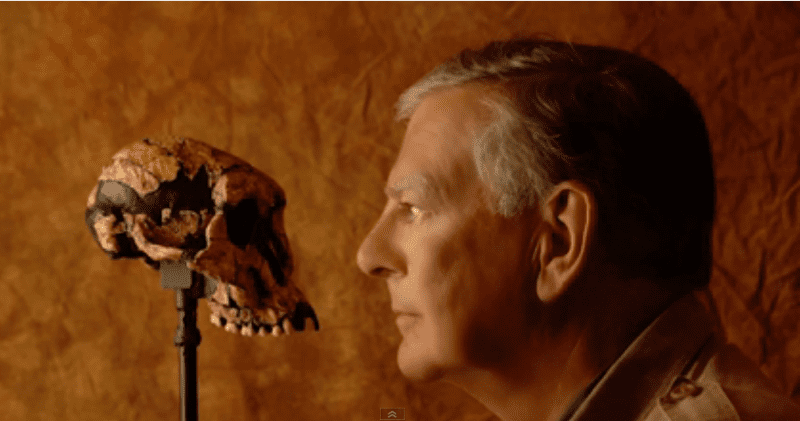And God made the beast of the earth after his kind and cattle after their kind, and every thing that creepeth upon the earth after his kind: and God saw that it was good. And God said, Let us make man in our image, after our likeness: and let them have dominion over the fish of the sea, and over the fowl of the air, and over the cattle, and over all the earth, and over every creeping thing that creepeth upon the earth. Genesis 1:25-26
It is clear from the Scriptures that God created all the Kinds of creatures separately from each other, that they could only reproduce after their Kind, and that things would stay that way from the beginning of life on earth until its end.
Evolution says that all the families, classes, orders, and phyla of living things came from one original kind of a simple bacteria germ. That every living thing on earth came from this original archaeobacter, not by reproducing after their own Kind, but by gradually crossing the genetic boundaries (by some unknown process) to develop all organisms from this one first organism.
This is not only not Biblical, it’s also not scientific. It is sci-fi fantasy material at best.
In their eagerness to prove that people and monkeys came from the same ancestor (which in turn came from a long series of mutants) evolutionists have leapt repeatedly at thinly-veiled and desperate attempts to assemble a sequence of “missing links” to prove that humans and monkeys came from the same breeding stock millions of years ago. This “Top Ten” list is by no means complete, but it is up-to-date and includes the most recognizable and recent “link” offerings found in evolutionist textbooks, documentaries, and museum displays.
Don’t forget: the Bible says God made only monkeys and men, no monkey-men. Evolution says that there most certainly were monkey-men.
1. “Toumai” (pronounced “too-migh”) meaning “child” in the local language
Sahelanthropus tchadensis (pronounced “sah-heh-lan-throw-pus chad-enz-sis”) means “Sahel man from Chad”
- In 2002, National Geographic splashed this skull on their front cover as our first ancestor to break from the chimps in Africa 7 million years ago.
- In 2004, UCal-Berkeley announced that is was in the same group with the known extinct ape Ardipithecus kaddaba.
- In 2006, UMich-AnnArbor said that a four-year study proved the bones could not been ancestral to humans.
- In 2007, evolution-based DNA analysis dated the human-chimp split at 6 million years ago, making Toumai a milllion years too early in the story.
2. “Orrorin” (pronounced “uh-roar-in”)
Orrorin tuginensis (“uh-roar-in too-kin-enz-sis”)
Originally, only a few skull fragments had been found, dated by evolutionists at 6 million years old. But some upper leg bone pieces were computer enhanced in 2008 and generated a hip socket connection that was much more human-like than the famous “Lucy” fossil which had been dated at 3 million years later.
This prompted many evolutionists to abandon Lucy as our human ancestor, since they placed great faith in the newer Orrorin fossil, and had been running into a great deal of trouble with the Lucy fossil anyway, as new bones showed her fingers and toes were better suited to swinging in the trees than chimpanzees today.
Lucy’s 1974 discoverer, Donald Johansen said, “Lucy has been dethroned.”
The same 2004 Berkeley report that classed Toumai as an ape, also classed Orrorin in that same group.
3. “Ardi” (“Arr-dee”)
Ardipithecus ramidus (“arh-dih-pith-ih-kus ram-ih-dus”) meaning “ground ape root”
Dated at about 4 million years old, it is also classed in the same ape group as the Ardipithecus kadabba of the 2004 Berkeley news release.
First found in 1982, not much was made of it until a specimen was reassembled from crushed bones in 2009, by Tim White of UCal-Berkeley. The bones were crushed and mixed in a bone-bed buried along with over 30 other ramidus skeletons, also crushed and mixed into the fossil bed along with over 50 skeletons of various birds and mammals.
The October 2009 issue of Science called “Ardi” our ancestor and listed long arguments of why the find was so significant to the story of human evolution. Team leader, Tim White, said however, “this is not that common ancestor, but it’s the closest we’ve ever been able to come.”
In every case, primary sources will claim that the “missing link” fossil is close but that some factor clearly disqualifies their discovery from being the elusive “missing link.” Original reports are often ignored and the fossil goes on display in magazines, museums, and finally in the high school and college textbooks as—you guessed it—the “missing link.”
Ardi had a thumb on her foot and could walk on all fours using her palms like the soles of her monkey-feet. At four feet tall and 110 pounds, she had a brain only one fifth the size of ours. Even chimpanzees and Lucy have brain-cases one third the size of ours. Ardi wasn’t even very brainy for a monkey.
4. “Lucy”
(named after the Beatles’ song “Lucy in the Sky with Diamonds,” which refers to use of the drug LSD, not surprisingly)
Australopithecus afarensis (“aw-strahl-uh-pith-i-kus aff-ah-renz-sis”) meaning “southern ape of Afar (a region of Ethiopia)”
Found in 1974 by Donald Johansen, it was famous for being 40% complete—most “link” fossils have only a few pieces of skull, teeth, or other bones. Only the left hip was found, and it was exactly like a chimp, meaning Lucy could not be our first walking ancestor. All reconstructions showed Lucy’s hands and feet like a modern human, even though there were no bones to show this. Evolutionists based this on the completely human footprints found on the same level in a layer of volcanic ash 600 miles away. The knee cap was found over a mile away.
Later finds showed the toes and fingers to be more curved than a chimp’s, unlike human straight toes and fingers. An infant fossil called “Dikkika” from a deeper layer evolutionists dated at 100,000 years older also had gorilla shoulder blades and a “divergent big toe” like a thumb on the foot.
At three and a half feet tall, 65 pounds, and a brain one-third the size of ours, adult Lucy was much like a chimp.
A supposedly male fossil two feet taller and popularized in the summer of 2010 which had much longer legs and was said by Owen Lovejoy of Kent State to be “an excellent runner,” will most likely be later determined to be a real human. But what will the evolutionists do about a human fossil found in the same layer with the Lucy fossil? This newer supposed afarensis has been named “Big Man,” but might really be from the Homo sapiens group that made those tracks in the ash at Laetoli.
5. Australopithecus africanus
(“aw-strahl-uh-pith-i-kus af-ri-kan-uss”) or “southern ape of Africa”
The problem was that africanus had long arms and shorter legs than Lucy, making him even more like a monkey than she was, even though he comes a million years later in the evo-understanding of the rock layers. Evolution says Lucy’s Kind became us. So, why isn’t africanus further along the way to becoming a human? This fossil is exactly the opposite of what evolution predicted it should be.
What’s the evo-answer to this? They say evolution for some unknown reason went backwards for a million years. Such thinking in science is called “inertial thinking,” meaning that new data will not change old ideas, no matter how clearly it disproves them. Evolutionary thinking is inertial thinking.
6. “Handy Man” was the deepest “link” fossil found associated with stone tools.
Homo habilis (pronounced “hoh-moh hah-bill-iss”) referring to “same” and to “tools”
Found in Asia and many other places, habilis strongly challenged the “Out of Africa” evolutionary hypothesis in favor of the “Multi-regional” evo-theory of how, when, and where monkeys turned into people. Fossils are incomplete and the “tools” likely belong to modern man.
In 2007, habilis fossils were potassium-argon ash dated as the same age as the 1.5 million year old Homo erectus monkey that it was supposed to have “evolved into” over the next one million years. Fred Spoor of University College of London said, “it’s like finding out that your grandmother and your great-grandmother were really sisters.” Clearly, there’s something wrong with this whole part of the evo-story.
7. “Upright Walking Man”
Homo erectus (“hoh-moh uh-rek-tuss”) referring to “same” and to “upright” (sometimes referred to as Homo ergaster)
One specimen, called “Turkana Boy” was found with a puncture in the skull, causing some evolutionists to say a bird of prey grabbed our youngster “ancestor” by the head, “proving” that once upon a time eagles hunted humans for food.
Erectus was reconstructed with a very human-like posture, even though this would have mostly likely been very uncomfortable and unnatural for the creature that had this skeleton. The biggest problem for evolutionists was the 2007 dating that set erectus living at the same time as habilis. This contradicts the evolutionist story.
Another problem was that the male and female skulls were so different in size. Called “sexual dimorphism,” this degree of difference is never found in humans, but is commonly found in apes and other animals.
In 2007, DNA studies done by evolutionists indicated “Homo erectus is almost certainly not our ancestor, but a dead end.” Erectus is just another extinct monkey from the time of another extinct monkey called habilis.
8. Homo antecessor
(“hoh-moh ant-iss-sess-er”) referring to “same” and to “before”
This little monkey has had so few bones found that it is still uncertain what it really might have looked like. As more bones are found, it might even turn out to be a human, but almost certainly is just another chimp fossil. Tools have been found associated with it near Gibraltar in Spain.
This is the only “human missing link” fossil that hasn’t had enough bones discovered yet to totally prove whether it is a human or a monkey. So, it is the only “link” that has not yet been totally disqualified from being evidence for the evolution story. Watch for new developments on the antecessor fossils.
9. “Neanderthal Man”
Homo neanderthalensis (“hoh-moh nee-ann-der-thall-enz-sis”) referring to “same” and the Neander Valley in Germany (“tal” – German for “valley”)
Originally found in the 1800’s and taught as the missing link until the 1980’s, Neanderthals are now known to have been totally human—not monkey-men, as originally thought.
Their brains were bigger than ours, they made musical instruments, did cave art, buried flowers with their dead (indicating thoughts of the afterlife), had makeup, made campfires, went on hunting trips, and liked colorful clothing. These are all human traits, placing Neanderthals on an entirely different level from all of the monkey fossils previously named.
Evo-dated as extinct 40,000 years ago, now new evo-dates place artifacts as recently as 25,000 years old. A teenager and a juvenile fossil have both been found with a mix of Neanderthal and modern traits. 4% of all Europeans have been found to be carrying Neanderthal DNA.
Neanderthals have now been re-classified as Homo sapiens neanderthalensis—just another tribe of humans.
10. “Cro-Magnon Man” and “Heidelberg Man”
New textbooks do not even mention Cro-Magnons or Heidelbergs, unless it is to say they are “archaic Homo sapiens”—in other words—us.







